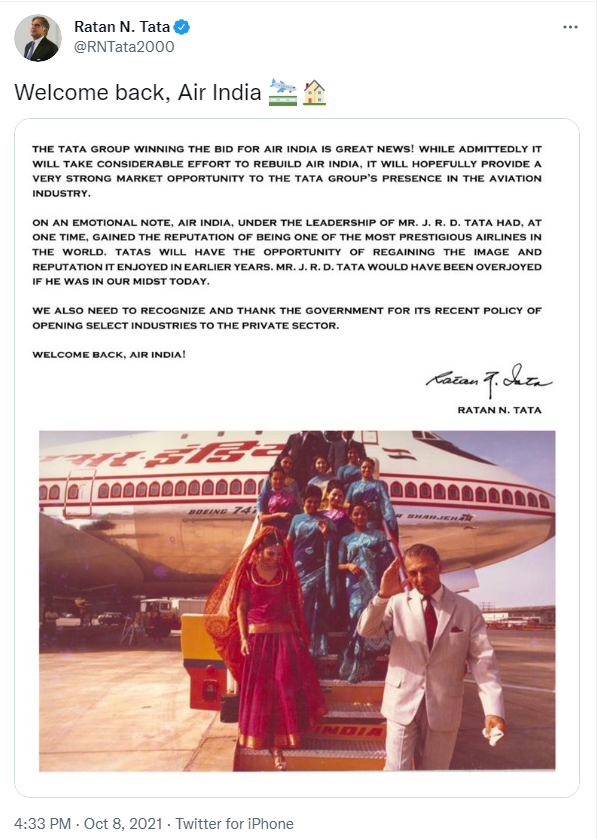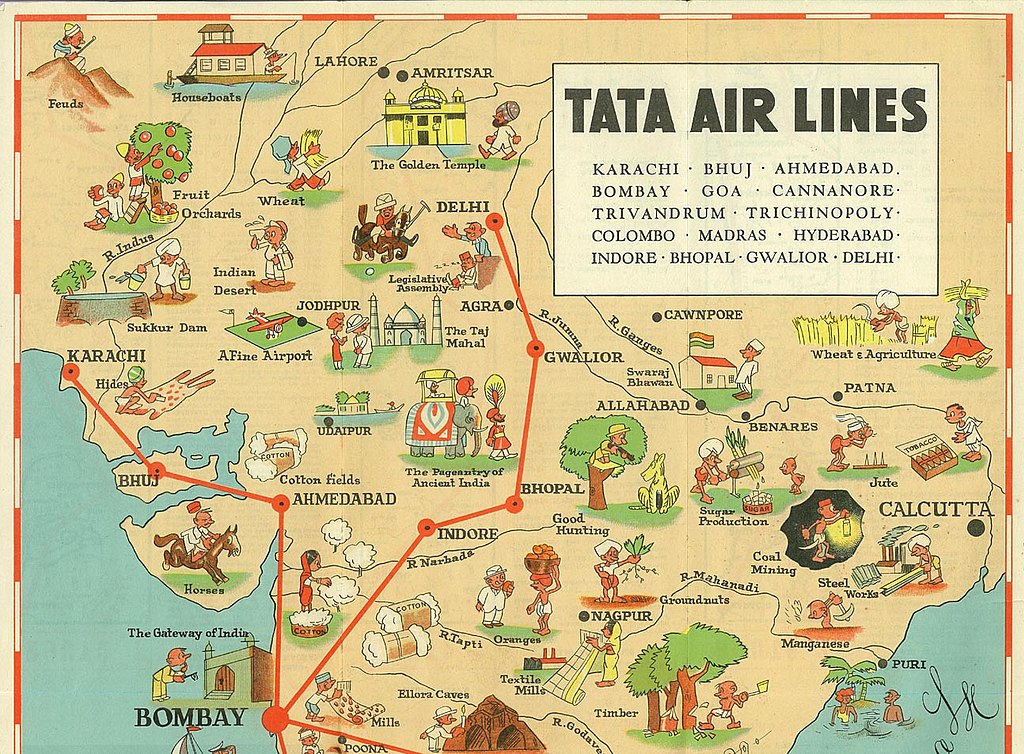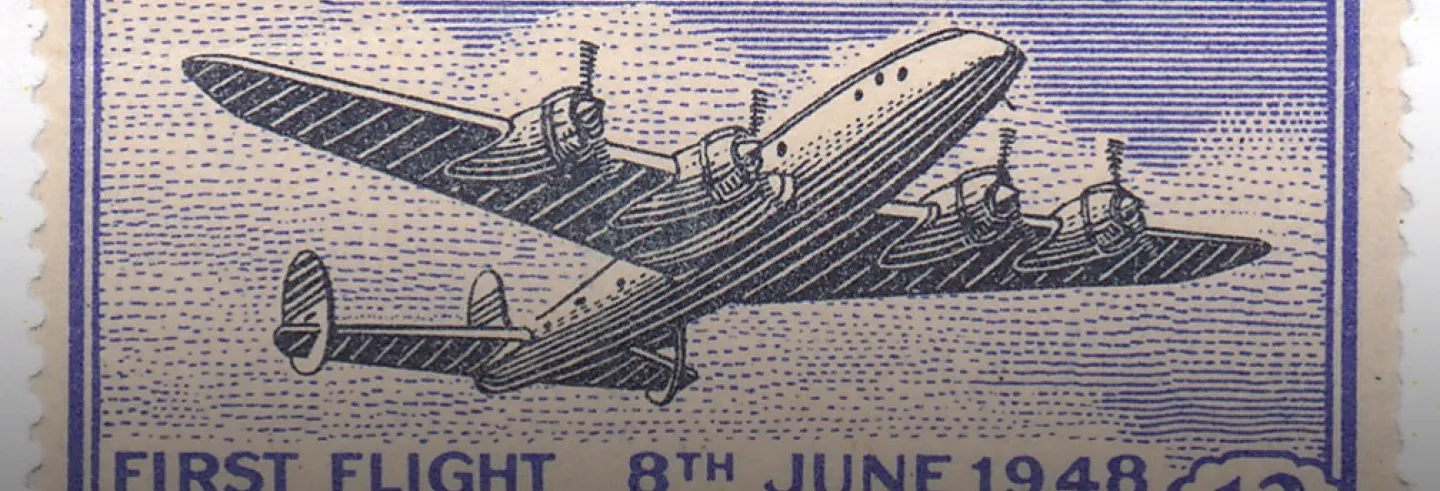On the day news broke that the Tata group had won the bid for Air India, Ratan Tata, chairman emeritus of the group, tweeted ‘Welcome back Air India’ along with a photograph of Jehangir Ratanji Dadabhoy (JRD) Tata exiting an Air India Boeing 747. Ratan Tata channelled the legacy of JRD, former chairman of Tata Sons and India’s most famous aviator, writing that by taking over the airline, the ‘TATAS WILL HAVE THE OPPORTUNITY OF REGAINING THE IMAGE AND REPUTATION IT ENJOYED IN EARLIER YEARS’.
In popular narratives, Tata's reacquisition of Air India, 68 years after it was nationalised, is a moment of triumph for private enterprise in its battle with the remnants of the Nehruvian state. Like Ratan Tata’s tweet, much of the reporting on the ‘return’ of the airline to Tata, 43 years after JRD was removed as its chairman, voiced hopes that under the management of his heirs, Air India might once more take its place among the most respected airlines in the world.
Through its history, the relationship between Tata's aviation ventures and the Indian state was often one of mutual interdependence.
We must take these narratives with caution. For, through its history, the relationship between Tata's aviation ventures and the Indian state was often one of mutual interdependence. A close analysis of the history of state policy on aviation also shows that the Indian government was more often swayed by international trends than by any clear-eyed formulation of policy or ideology.
Understanding the acquisition of Air India by Tata involves placing Indian civil aviation in its specific historical context. This means not only looking at Tata but also at the historical development of the Indian state and widespread international trends in the field of aviation.
The early decades
From its very beginning, Tata's aviation venture was closely involved with the Indian state. In colonial India, it had to be so. Ties between the Tata group and the colonial government dated back to the late 19th century, long before the establishment of Tata Air Services (TAS) in 1932. Much of the Tata fortune had been made outfitting the British Indian military expeditions to Abyssinia in 1898. The famed Tata Iron and Steel Company had been set up with the cooperation of the colonial government in 1907. It was these close links between the biggest Indian business house and the colonial government that enabled JRD to gain the permissions necessary to start an airmail service.
Though TAS would famously operate without government subsidies, it was dependent on the state in several other ways. Tata aircraft depended on what little aviation infrastructure the government was willing to provide, and the venture would make its first slender profits off deliveries of mail brought from Britain by Imperial Airways. Tata Air Services’ fortunes began to rise substantially with the introduction of the Empire Air Mail scheme in 1938, which delivered mail along an air route spreading out from London all the way to Sydney. While Imperial Airways aircraft would transit through Karachi, Delhi, and Calcutta, mail from other Indian cities would be gathered by two Indian carriers: TAS and Indian National Airways. Thanks to the scheme, TAS profits increased tenfold. The purchase of larger planes from these profits helped increase passenger numbers sixfold. The first Indian airline thus benefitted materially from a plan that aimed to centralise the empire.
The outbreak of the Second World War put an end to the Empire Air Mail scheme. During the war, Tata Airlines (as the service was renamed in 1938) provided the government of India several services. These included the evacuation of refugees from Burma and the other Asian countries overrun by the Japanese, the survey of new air routes, and the overhauling of aircraft. JRD also embarked on an abortive plan to establish a glider factory for the war effort. By the end of the war, the government and Tata were working so closely together that Tata Aircraft Ltd (founded 1942) was designated as the government’s agent for the resale of the large amount of aircraft bought by India from the the United States' surplus military stock.
Tata not only tolerated state intervention in aviation but also actively sought state protection from competition.
In the aftermath of the war, Tata Airlines benefited from a post-war boom in Indian aviation, occasioned by the availability of cheap aircraft, trained pilots, and extended infrastructure. The profitability of Indian civil aviation, however, was a different matter. Several new airline companies sought to enter the market, helped by the huge profits made by Indian industrialists during the war and attracted by the low cost of entry into civil aviation. Tata’s rival Birla group, for instance, launched Bharat Airways, as a ‘patriotic enterprise’, despite JRD warning the group’s patriarch Ghanshyam Das Birla not to enter the airline sector. An increase in the number of airlines, JRD wrote, would drive down profitability and eventually lead to nationalisation. (On his part, Birla attacked Tata for being ‘anti-national’ since the group hired a large number of foreigners for their airline.)

For JRD, the answer to the emerging problem was simple: state regulation of competition.
He supported a plan put forward by his close associate Frederick Tymms, the director of civil aviation, which would have limited the number of licences granted for airlines. This was never adopted by the provisional government of India — becoming a casualty of the dysfunction arising from tensions over Partition between Congress and Muslim League ministers. But JRD's support for the Tymms plan is indicative of the extent to which the group not only tolerated state intervention in aviation but also actively sought state protection from competition.
Air India served as a model for Tata to push for ‘joint-sector enterprises’, where the state held most of the ownership, but management remained in private hands.
Even as Indian domestic aviation was transformed, Tata established Air India International jointly with the government of independent India in 1948 at a cost of 2 crore rupees. The government would hold 49% of the shares with an option to acquire an additional 2% at any time. Air India would hold 25% and the remaining 26% would be sold to the public. Significantly, the government committed to cover any losses incurred in the first five years, which could then be paid back with future profits.
The establishment of the airline in the shadow of independence and Partition has rightly been hailed as JRD’s greatest achievement in the field of aviation. The historian Mircea Raianu, author of a book on the Tata group, places the founding in the wider context of relations between Tata and the newly independent Indian state embarking on a path towards greater industrialisation. He argues that Air India served as a model for Tata to push for ‘joint-sector enterprises’, where the state held most of the ownership, but management remained in private hands. With a shortage of capital in the years following independence, JRD sought a system that would trade his firm’s managerial experience in return for state investment. The example of Air India, in which the government had invested heavily but left the day-to-day running in the hands of Tata, would later be used to call for similar joint-sector investments in other Tata enterprises, like Tata Iron and Steel Company.
In effect, JRD sought state investments without state control. He would arguably achieve this to a degree thanks to airline nationalisation in 1953.
Aviation as a state monopoly
The dominant view today is that the Nehruvian state undertook the nationalisation of air transport due to its socialist ideology. While there may well be some truth to this claim, the Nehruvian state was not alone in being attracted to aviation. Airline nationalisation was popular in countries across the world, as much in capitalist Western Europe as in newly decolonised Asia and Africa. The French government, for instance, nationalised civil aviation in 1945. Indonesia and Egypt, later India’s closest partners in the Non-Aligned Movement, nationalised their airlines in the 1940s.
Indian politicians, like their peers across the world, held the widespread belief that nationalisation was the future of civil aviation.
The greatest single influence on India, however, came from the United Kingdom, whose largest airline, British Overseas Airways Corporation, had been created by an act of parliament as a state-owned airline. Influential international trends of that time held that the state was best placed to run airlines. Indian politicians, like their peers across the world, held the widespread belief that nationalisation was the future of civil aviation.
This conviction however was not accompanied by a coherent programme for the implementation of nationalisation in India. As a confidential report from the British Commonwealth Relations Office noted in 1953, “The most striking feature here is firm determination of the government to nationalise and its complete weakness in settling the methods of nationalisation.” It would be this weakness in government planning that would result in the creation of two airline corporations, one of which would be led by JRD.
The government taking over air transport had the consequence of entrenching Air India International while substantially weakening domestic civil aviation.
The Planning Commission had advised the government to create a single air corporation that would handle both domestic and international air routes. But India opted for two, to compromise with JRD, whose managerial services it wished to retain after nationalisation. (Left-wing critics accused Prime Minister Jawaharlal Nehru of pandering to capitalists with this decision.)
Contrary to the present narrative about nationalisation as a moment of state conflict with the ‘father of Indian aviation’, the government taking over air transport had the consequence of entrenching Air India International while substantially weakening domestic civil aviation. Air India retained its management, its name, its personnel and even its icon: the Maharaja. It would also absorb some assets from Birla’s Bharat Airways, which had services to east Asia. Air India shareholders would also receive substantial compensation, amounting to some 2.8 crore rupees, the largest received by any airline. Meanwhile, the eight other corporations that were absorbed into Indian Airlines — Deccan Airways, Airways India, Bharat Airways, Himalayan Aviation, Kalinga Airlines, Indian National Airways, Air Services India, and Air India (domestic) — underwent a complex and at times poorly organised integration process.
The quarter-century following nationalisation, when Air India was under Tata stewardship, is remembered fondly by both scholars and many in the Indian middle classes as the golden age of the airline. Under the chairmanship of JRD, Air India was well regarded internationally as an airline that was efficient, punctual, and glamorous. This image of the airline however papered over serious contradictions in nationalisation. Despite being taken over by the state, Air India was effectively run as a Tata company, with absolute power vested in the person of JRD. This structure relied less on a clear policy adopted by the government and more on the personal relationship between JRD and the Nehru-Gandhi family. After JRD voiced his support for Indira Gandhi’s Emergency, it was inevitable that he would be removed from the chairmanship of Air India in 1978 when the Janata government came to power.
Many of the trends that were later used to push a narrative of Air India’s ‘decline’ were already apparent during JRD’s time as chairman.
While much of the present coverage of the Tata acquisition of Air India is fixated on JRD’s unceremonious removal from Air India, little consideration is given to the wider structures of the corporation. On the one hand, Air India was effectively placed under JRD’s management for some 25 years with no clear plans for a successor. On the other hand, Air India itself was not constituted as a statutory company, which would have given it some degree of independence. This meant that political interference was just a matter of time.
Many of the trends that were later used to push a narrative of Air India’s ‘decline’ were already apparent during JRD’s time as chairman. Political interference had begun to manifest itself in the form of interventions into company affairs by Sanjay Gandhi, the prime minister’s son. There is also some evidence that labour unrest had begun to plague the airline, which may have furthered JRD’s support for the Emergency. Other signs of trouble too loomed in the form of surging oil prices in the mid-1970s. It is as such important to treat the end of JRD’s chairmanship as one among a constellation of factors that contributed to the declining profitability of Air India.
Privatisation
Despite the many crises facing it, Air India continued to remain a profitable enterprise, albeit one that was increasingly reliant on the air routes connecting migrant workers from India to the employment hubs of the Persian Gulf. By the mid-1980s however, the belief in the benefits of nationalisation had begun to wane across the world. This was a consequence of several factors including skyrocketing fuel prices, high costs of maintaining ageing air fleets, increasing labour unrest, and unprofitable air routes.
In a world that no longer considered national flag carriers as an essential symbol of statehood, flag carriers across the globe from Peru to Italy either ended operations or were privatised.
But the most important change in attitudes towards state ownership of aviation was ideological. In the decades after the Second World War national airlines were seen as important symbols of the nation-state that were meant to place national service above profit. However, with the spread of neoliberal ideology across the world, national airlines came increasingly to be judged solely based on their profitability. In a world that no longer considered national flag carriers as an essential symbol of statehood, flag carriers across the globe from Peru to Italy either ended operations or were privatised.

As they had with nationalisation, Indian politicians took their cues on privatisation from abroad, with little by way of serious consideration of the condition of aviation in India. The first steps were taken stealthily by Nehru’s grandson, Prime Minister Rajiv Gandhi, who permitted ‘air taxi’ services in 1986. Prime Minister P.V. Narasimha Rao would formally end the state monopoly in 1994, as part of the wider process of the liberalisation of the Indian economy. Privatisation was proclaimed to be the future of air transport with much the same certainty in 1994 as nationalisation had been in 1953.
Seventy-five years after independence, a coherent aviation policy continues to elude the government of India.
The new era of privatisation however has not proved to be an unmixed blessing for either public or private airline operators. Both Air India and Indian Airlines experienced their worst crises in the three decades since 1994. Both have suffered due to chronic mismanagement, political malfeasance, and arguably a loss of faith in the role of public enterprises by both the political and the middle classes. The two airlines were merged in 2007 and have gone on to make record losses since.
Privately run airlines have failed, often spectacularly, in a field that is not only characterised by intense competition but also subject to external shocks including economic crises and pandemics. Despite the number of Indian flyers increasing to around 150 million in 2019 from 9.5 million in 1993, one private airline after another has gone bust. Nearly all the major private airlines established over the last three decades have either been bought over or gone bankrupt. The parlous condition of private carriers and calls for government aid to prevent the collapse of private operators are reminiscent of the chaotic state of civil aviation from 1946 to 1953, which provided the justification for nationalisation. Seventy-five years after independence, a coherent aviation policy continues to elude the government of India.
Conclusion
From the perspective of Tata's recent corporate history, there is reason to view the takeover of Air India with cautious pessimism. In a recent email exchange, Mircea Raianu pointed to the similarities between the Air India acquisition and Tata's expensive purchase of Corus Steel in 2006, both of which were attempts to right what the group views as historical wrongs committed against the group. In the Corus case, by taking over Britain’s most important steel producer, Tata symbolically avenged itself against British industrialists who had dismissed the company’s capacity to make steel in the early 20th century. However, the Corus acquisition has turned out to be both financially unrewarding and politically volatile. So too could Air India, in a period when the airline industry across the world is in the midst of a major contraction due to Covid-19 and climate change.
Narratives around Air India’s past indicate how history is used as a resource to explain and at times even justify present-day developments.
History may not offer clear lessons that can be used to predict Air India’s future. But the narratives around Air India’s past indicate how history is used as a resource to explain and at times to even justify present-day developments. Much of the impetus for this mobilisation of history as a resource comes from Tata itself. Well aware of the legitimacy conferred by history, JRD meticulously recorded and commemorated his achievements in the field of aviation. Tata also commissioned glowing biographies and JRD has the distinction of being one of the few Indian industrialists to establish a dedicated archive. Some measure of the success of the historical narrative promoted by Tata amongst middle-class Indians, can be had from the widespread celebration of Ratan Tata’s tweet on Air India.
Yet, examples and analogies from the past are of limited use outside their specific historical context. Taking the claims on history made by Tata and many in the press at face value carries many risks. This includes turning history into a vehicle for corporate aggrandizement, reducing it to a simple story of a struggle pitting the state against private enterprise and drawing dubious ‘lessons’ from the past. Failing to place events in their context serves not only to provide us with the wrong lessons but also to misunderstand the past.









